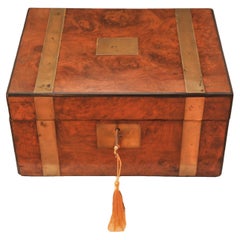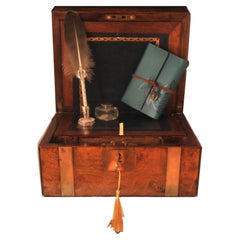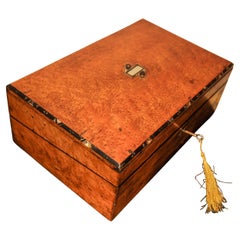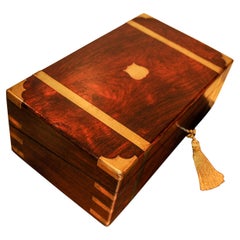Antique Lap Desk From The 1800s
Antique 19th Century British Campaign Desk Sets
Brass
Antique 19th Century British Campaign Desk Sets
Brass
Recent Sales
Antique 19th Century British Campaign Desk Sets
Brass
Antique 19th Century British Campaign Desk Sets
Brass
Antique 19th Century British Campaign Desk Sets
Brass
Antique 19th Century British Campaign Desk Sets
Brass
People Also Browsed
Early 2000s Irish Modern Jewelry Boxes
Mahogany, Walnut
Antique Late 19th Century European Moorish Architectural Elements
Wrought Iron
Vintage 1920s Danish Scandinavian Modern Bookcases
Mahogany
Antique Late 19th Century English High Victorian Decorative Boxes
Brass
Antique 19th Century British Victorian Desk Sets
Brass
Mid-20th Century British Campaign Chairs
Brass
Antique 19th Century British Regency Desk Sets
Brass
21st Century and Contemporary Vietnamese Campaign Desks and Writing Tables
Leather, Wood
Mid-20th Century English Renaissance Beds and Bed Frames
Oak
Antique 1880s Italian Napoleon III Decorative Boxes
Sterling Silver
Antique Mid-19th Century British Victorian Desk Sets
Leather, Mahogany
Antique Late 19th Century Indian Campaign Decorative Boxes
Brass
Antique 1840s English Early Victorian Desks
Leather, Hardwood
Antique 1820s American Campaign Desks and Writing Tables
Crystal, Brass
Antique Mid-19th Century French Dry Bars
Crystal, Bronze, Brass
Antique Early 19th Century French Charles X Architectural Elements
Stone, Copper
A Close Look at Campaign Furniture
Sometimes called “knock-down” furniture, campaign furniture was designed to be folded, collapsed, taken apart and packed flat to load onto a ship or a camel’s back. Although mobile furniture for military campaigns dates back to the Romans, the British Army in its global conquests in the 18th and 19th centuries defined the style with sturdy and elegant pieces. Even in a tent thousands of miles from London, a four-poster bed, dining table and seating could simulate the comforts of home.
Antique and vintage campaign-style furniture was also initially designed as propaganda. The mahogany and teak structures were part of a purposeful demonstration of power in these campaigns, with the colonizing military officers imposing their culture and view of what they considered “civilized” on a given land and its peoples. Designers and manufacturers including Thomas Butler, Ross & Co. of Dublin, and Morgan & Sanders contributed to the rapid production of this furniture as the British Empire expanded through Africa, Asia and Australia.
Campaign furniture was utilitarian as well as refined, fitted with recessed brass handles and brass angles on stackable chests and other case pieces to protect vulnerable corners. The Wellington chest was one of the most famous pieces to come out of this style, named for the Duke of Wellington, who slept in his campaign bed long after his battles were over.
The flexibility of campaign-style furniture would influence 20th-century Scandinavian modernists such as Kaare Klint, Mogens Koch and Arne Norell. For his 1930s Safari chair, Klint drew on the simple Roorkhee chair, named for a town in northern India. The lightweight and adaptable campaign-style seat was created in the late 19th century and had no fixed joinery. The Roorkhee’s influence can also be seen in the Wassily chair, a pared-down work of tubular metal and durable canvas conceived by legendary Bauhaus instructor Marcel Breuer.
Now, 21st-century designers like Jomo Tariku and Dokter and Misses are creating pieces that recognize the contributions of African artisans to campaign furniture in order to reframe this style without overlooking its difficult past.
Find a collection of authentic antique and vintage campaign bedroom furniture, chairs, decorative objects and other pieces on 1stDibs.
Finding the Right Decorative-boxes for You
Antique, vintage and new decorative boxes will safely store items while adding a splash of color or texture to a corner in any room. They have had a range of purposes over the years — from trinkets to serving as useful receptacles, such as snuff boxes, jewelry boxes and more. Boxes have also been designed in a range of forms and styles.
Box making is a craft dating back thousands of years. Early boxes as decorative objects were regularly designed and decorated both inside and out, ranging from minimal looks to more flashy styles. Decorative boxes have been constructed from different materials, with wood and metal being the most common. Wood is widely available and versatile, with woodworkers able to carve complex designs or showcase its natural grain.
Some antique jewelry boxes were made with tortoiseshell, mother-of-pearl, ivory and even porcupine quills, such as those created by the Anishinabe in Canada and the United States. In Sri Lanka, well-crafted boxes were inlaid with porcupine quills and ivory discs between ebony bands. Chinese sewing boxes and tea boxes made of black lacquer were popular in Europe during the late 18th and early 19th centuries. These often featured gold-painted designs or landscape scenes. Silk, paper and velvet frequently enhanced these boxes’ interiors.
Any style of decorative box can be a nice tabletop or desktop decor, whether to hold candy or tea in the living room or paper, pencils and other business supplies in the office. They can also act as jewelry boxes. Sewing boxes can be a lovely touch to any space while storing magazines or other trinkets.
You can find metal, wood and silver antique boxes on 1stDibs. The collection includes mid-century modern, Victorian and Art Deco styles that can add elegance to any home.



